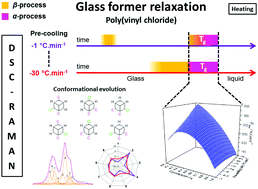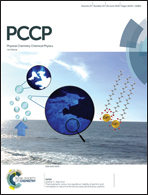Stereodynamic insight into the thermal history effects on poly(vinyl chloride) calorimetric sub-glass and glass transitions as a fragile glass model†
Abstract
The dynamic thermal history impact of poly(vinyl chloride) (PVC) has been explored for a wide range of pre-cooling rates, from 1 to 30 °C min−1. A first macroscopic insight into the dynamic thermal history influence has been highlighted through a decrease in the apparent activation energy (Eapp) in the first stage of the glass transition. The overall glass transition Eapp surface was successfully modeled in a polynomial fashion regarding the pre-cooling range. Raman scattering was used to associate the Eapp variations along the glass transition conversion with the stereochemistry evolution during the polymeric relaxation. Herein, the selection of atactic PVC as the polymer model permits us to monitor the glassy polymer segment stereodynamics during the heating ramp through the C–Cl stretching. The intermolecular H–Cl dipole interactions, as well as intramolecular conformational reorganizations among syndiotactic, isotactic and heterotactic polymer sequences, have been associated with non-cooperative and cooperative motions, i.e. the β- and α-process, respectively. The fruitful comparison of the two extreme values of the pre-cooling rates permits us to propose a thermokinetic scenario that explains the occurrence, intensity, and inter-dependence of β- and α-processes in the glassy state and during the glass transition. This scenario could potentially be generalized to all the other polymeric glass-formers.



 Please wait while we load your content...
Please wait while we load your content...